Contemporary Labor Market Trends and HR Evaluation
VerifiedAdded on 2023/06/09
|13
|2201
|222
AI Summary
The report provides an overview of the labor market along with evaluation of Human Resource (HR). The report however commences with a discussion on contemporary trends in the labor market of UK and Saudi Arabia. There is also discussion on how the organizations strategically position them in the competitive labor markets. The report also puts forward a discussion on the tight and the loose labor market conditions. The report also undertakes an evaluation of the HR approaches based on an article provided.
Contribute Materials
Your contribution can guide someone’s learning journey. Share your
documents today.
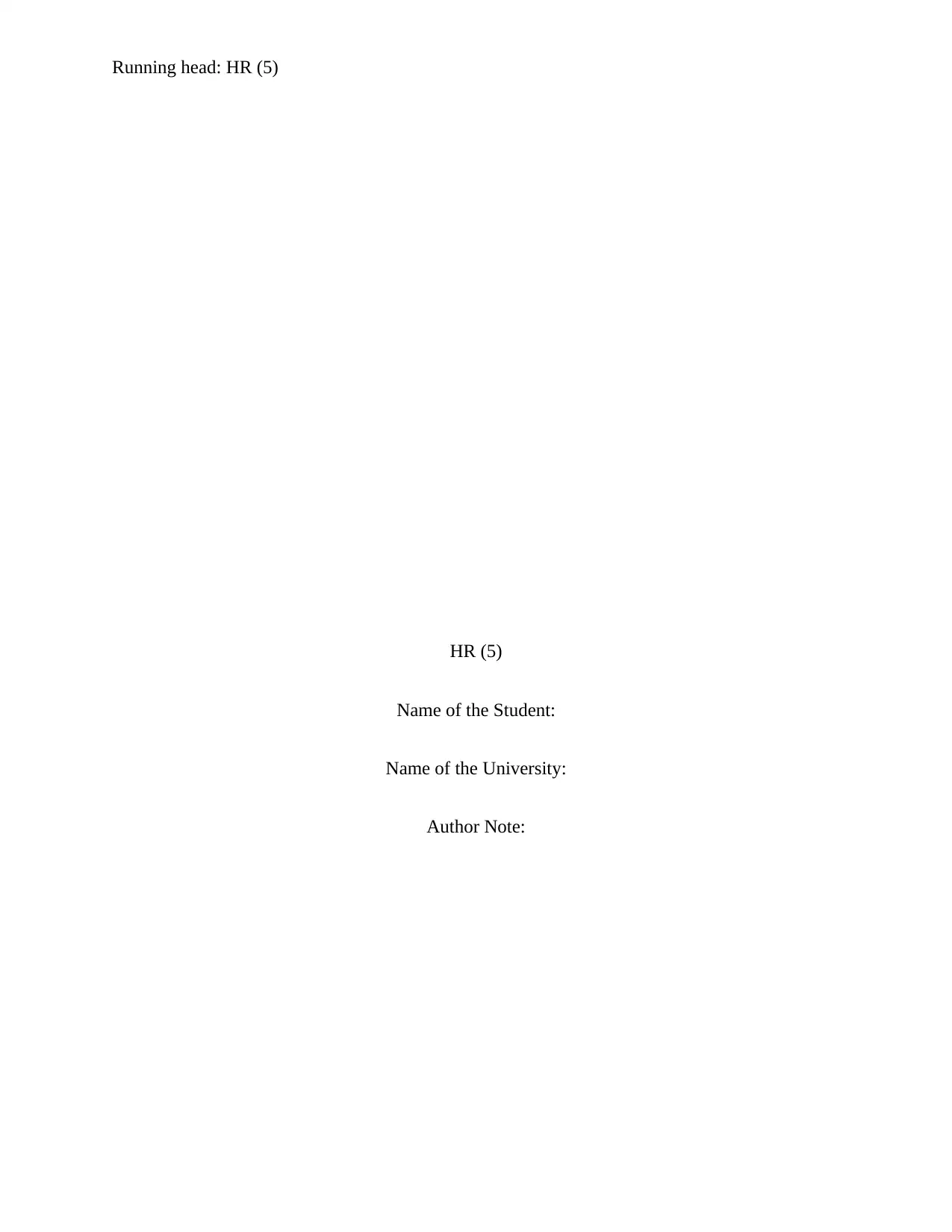
Running head: HR (5)
HR (5)
Name of the Student:
Name of the University:
Author Note:
HR (5)
Name of the Student:
Name of the University:
Author Note:
Secure Best Marks with AI Grader
Need help grading? Try our AI Grader for instant feedback on your assignments.
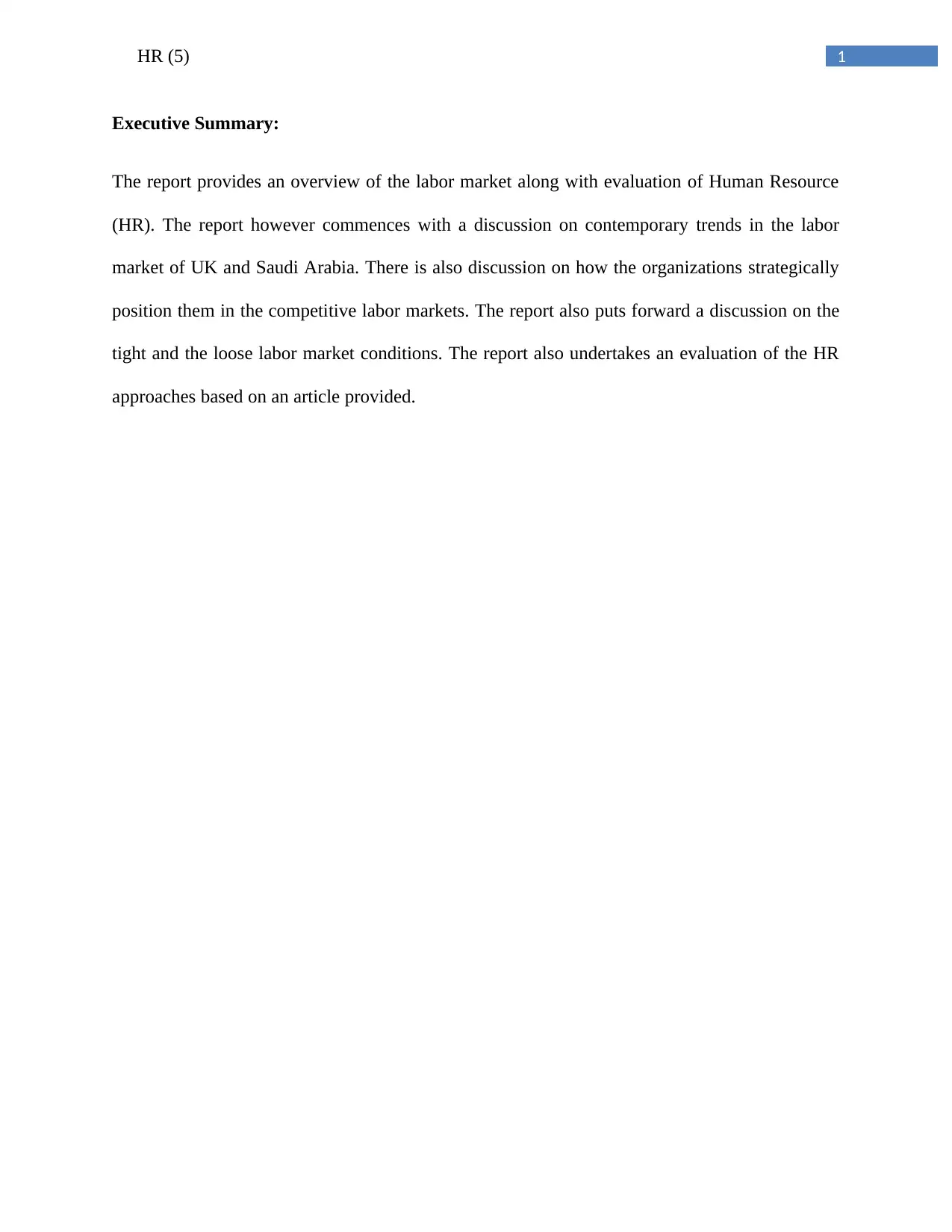
1HR (5)
Executive Summary:
The report provides an overview of the labor market along with evaluation of Human Resource
(HR). The report however commences with a discussion on contemporary trends in the labor
market of UK and Saudi Arabia. There is also discussion on how the organizations strategically
position them in the competitive labor markets. The report also puts forward a discussion on the
tight and the loose labor market conditions. The report also undertakes an evaluation of the HR
approaches based on an article provided.
Executive Summary:
The report provides an overview of the labor market along with evaluation of Human Resource
(HR). The report however commences with a discussion on contemporary trends in the labor
market of UK and Saudi Arabia. There is also discussion on how the organizations strategically
position them in the competitive labor markets. The report also puts forward a discussion on the
tight and the loose labor market conditions. The report also undertakes an evaluation of the HR
approaches based on an article provided.
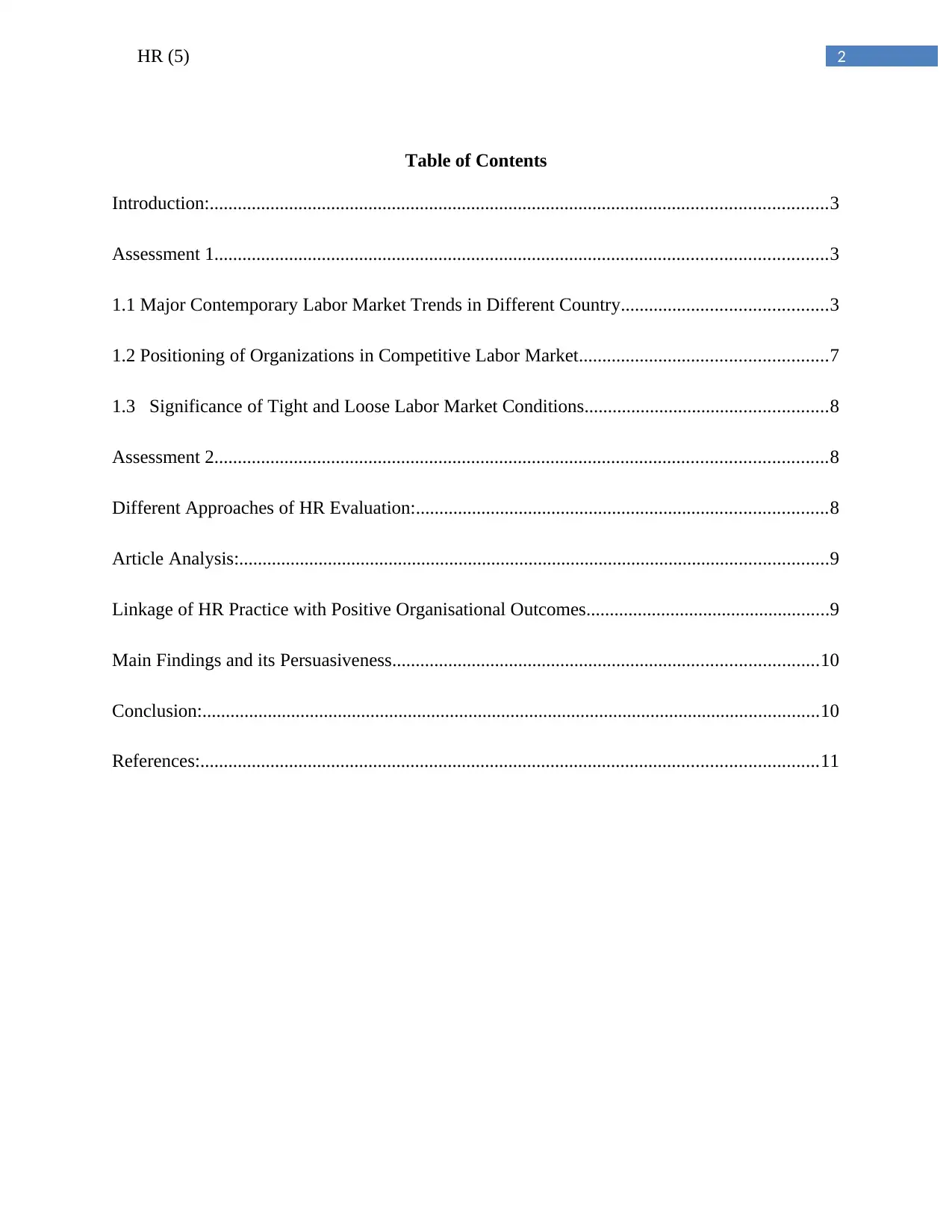
2HR (5)
Table of Contents
Introduction:....................................................................................................................................3
Assessment 1...................................................................................................................................3
1.1 Major Contemporary Labor Market Trends in Different Country............................................3
1.2 Positioning of Organizations in Competitive Labor Market.....................................................7
1.3 Significance of Tight and Loose Labor Market Conditions....................................................8
Assessment 2...................................................................................................................................8
Different Approaches of HR Evaluation:........................................................................................8
Article Analysis:..............................................................................................................................9
Linkage of HR Practice with Positive Organisational Outcomes....................................................9
Main Findings and its Persuasiveness...........................................................................................10
Conclusion:....................................................................................................................................10
References:....................................................................................................................................11
Table of Contents
Introduction:....................................................................................................................................3
Assessment 1...................................................................................................................................3
1.1 Major Contemporary Labor Market Trends in Different Country............................................3
1.2 Positioning of Organizations in Competitive Labor Market.....................................................7
1.3 Significance of Tight and Loose Labor Market Conditions....................................................8
Assessment 2...................................................................................................................................8
Different Approaches of HR Evaluation:........................................................................................8
Article Analysis:..............................................................................................................................9
Linkage of HR Practice with Positive Organisational Outcomes....................................................9
Main Findings and its Persuasiveness...........................................................................................10
Conclusion:....................................................................................................................................10
References:....................................................................................................................................11
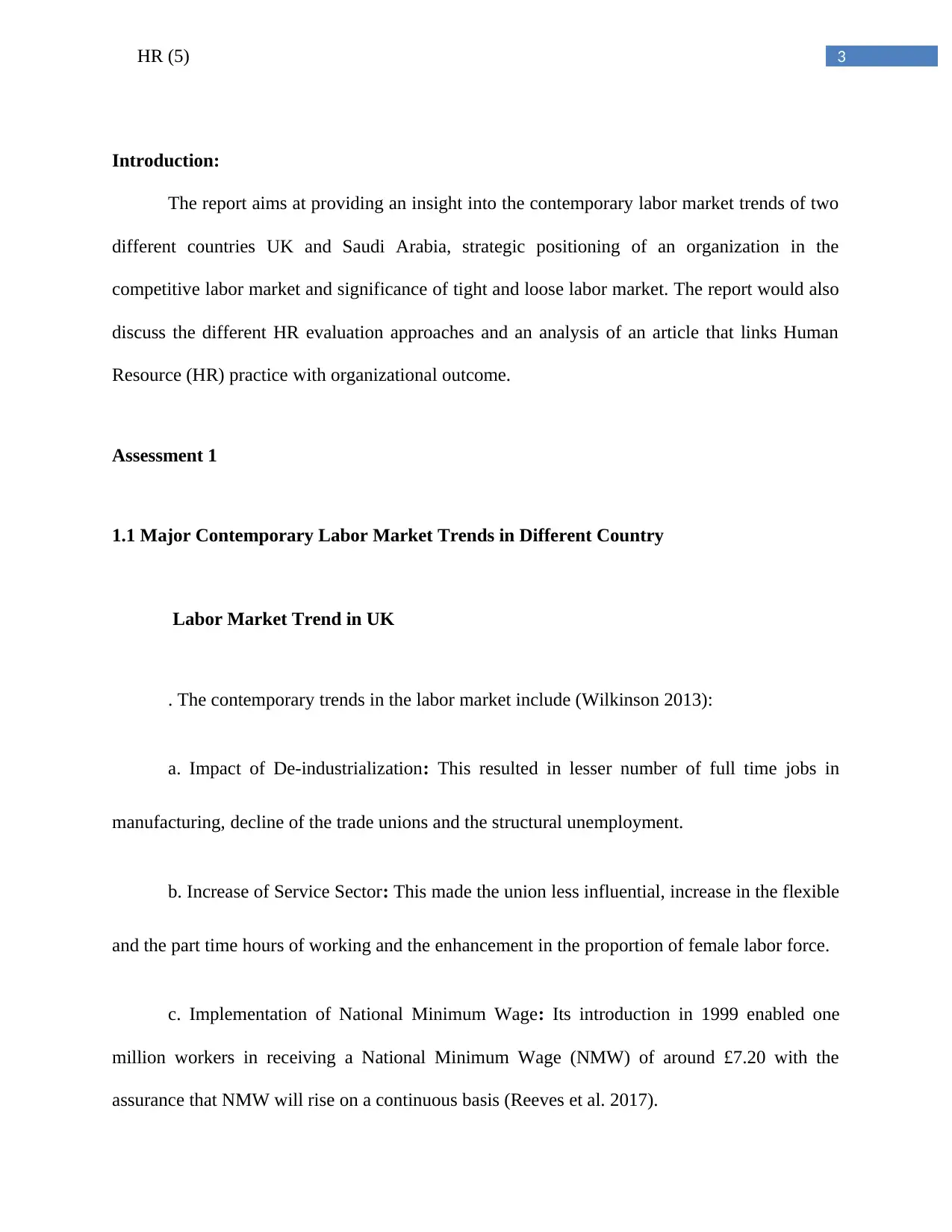
3HR (5)
Introduction:
The report aims at providing an insight into the contemporary labor market trends of two
different countries UK and Saudi Arabia, strategic positioning of an organization in the
competitive labor market and significance of tight and loose labor market. The report would also
discuss the different HR evaluation approaches and an analysis of an article that links Human
Resource (HR) practice with organizational outcome.
Assessment 1
1.1 Major Contemporary Labor Market Trends in Different Country
Labor Market Trend in UK
. The contemporary trends in the labor market include (Wilkinson 2013):
a. Impact of De-industrialization: This resulted in lesser number of full time jobs in
manufacturing, decline of the trade unions and the structural unemployment.
b. Increase of Service Sector: This made the union less influential, increase in the flexible
and the part time hours of working and the enhancement in the proportion of female labor force.
c. Implementation of National Minimum Wage: Its introduction in 1999 enabled one
million workers in receiving a National Minimum Wage (NMW) of around £7.20 with the
assurance that NMW will rise on a continuous basis (Reeves et al. 2017).
Introduction:
The report aims at providing an insight into the contemporary labor market trends of two
different countries UK and Saudi Arabia, strategic positioning of an organization in the
competitive labor market and significance of tight and loose labor market. The report would also
discuss the different HR evaluation approaches and an analysis of an article that links Human
Resource (HR) practice with organizational outcome.
Assessment 1
1.1 Major Contemporary Labor Market Trends in Different Country
Labor Market Trend in UK
. The contemporary trends in the labor market include (Wilkinson 2013):
a. Impact of De-industrialization: This resulted in lesser number of full time jobs in
manufacturing, decline of the trade unions and the structural unemployment.
b. Increase of Service Sector: This made the union less influential, increase in the flexible
and the part time hours of working and the enhancement in the proportion of female labor force.
c. Implementation of National Minimum Wage: Its introduction in 1999 enabled one
million workers in receiving a National Minimum Wage (NMW) of around £7.20 with the
assurance that NMW will rise on a continuous basis (Reeves et al. 2017).
Secure Best Marks with AI Grader
Need help grading? Try our AI Grader for instant feedback on your assignments.
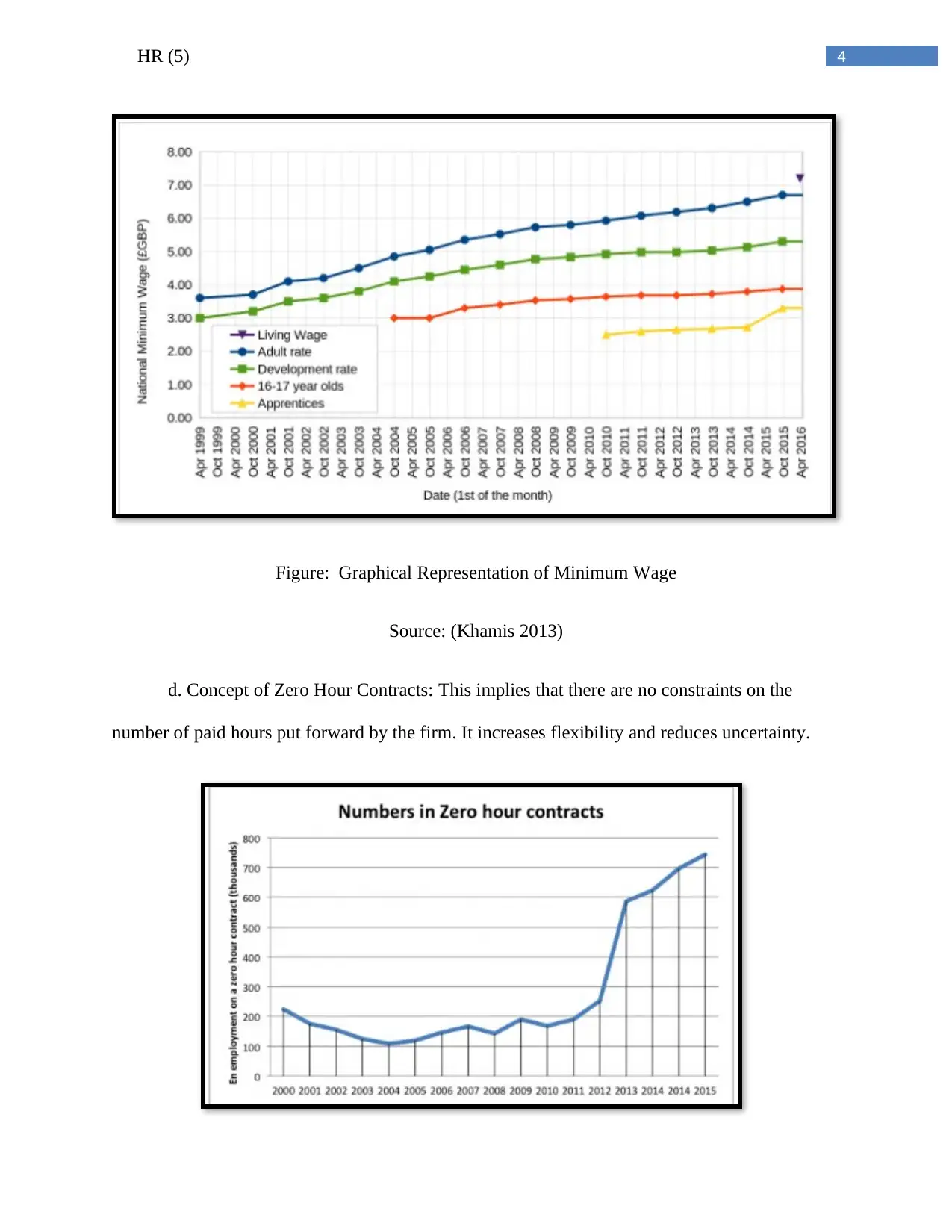
4HR (5)
Figure: Graphical Representation of Minimum Wage
Source: (Khamis 2013)
d. Concept of Zero Hour Contracts: This implies that there are no constraints on the
number of paid hours put forward by the firm. It increases flexibility and reduces uncertainty.
Figure: Graphical Representation of Minimum Wage
Source: (Khamis 2013)
d. Concept of Zero Hour Contracts: This implies that there are no constraints on the
number of paid hours put forward by the firm. It increases flexibility and reduces uncertainty.
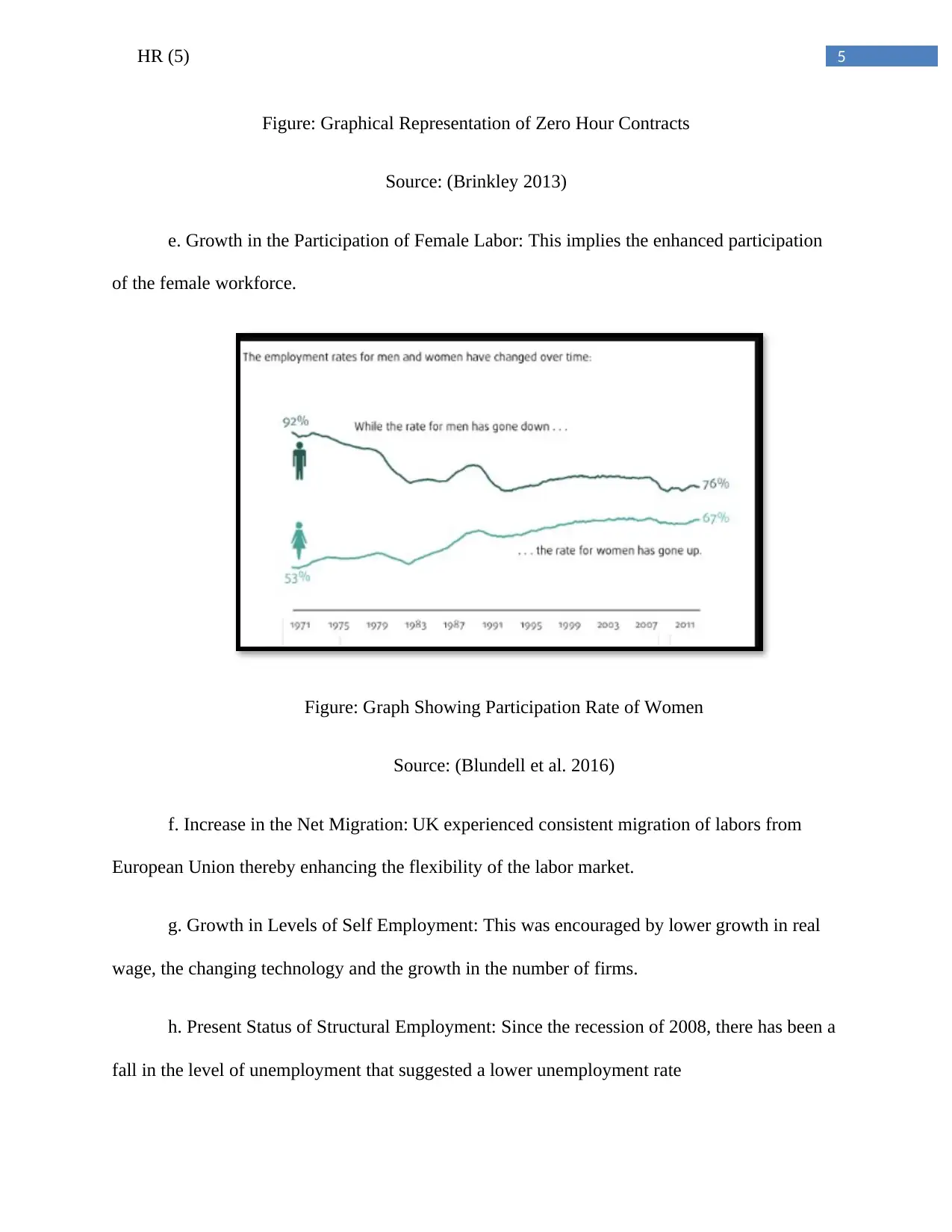
5HR (5)
Figure: Graphical Representation of Zero Hour Contracts
Source: (Brinkley 2013)
e. Growth in the Participation of Female Labor: This implies the enhanced participation
of the female workforce.
Figure: Graph Showing Participation Rate of Women
Source: (Blundell et al. 2016)
f. Increase in the Net Migration: UK experienced consistent migration of labors from
European Union thereby enhancing the flexibility of the labor market.
g. Growth in Levels of Self Employment: This was encouraged by lower growth in real
wage, the changing technology and the growth in the number of firms.
h. Present Status of Structural Employment: Since the recession of 2008, there has been a
fall in the level of unemployment that suggested a lower unemployment rate
Figure: Graphical Representation of Zero Hour Contracts
Source: (Brinkley 2013)
e. Growth in the Participation of Female Labor: This implies the enhanced participation
of the female workforce.
Figure: Graph Showing Participation Rate of Women
Source: (Blundell et al. 2016)
f. Increase in the Net Migration: UK experienced consistent migration of labors from
European Union thereby enhancing the flexibility of the labor market.
g. Growth in Levels of Self Employment: This was encouraged by lower growth in real
wage, the changing technology and the growth in the number of firms.
h. Present Status of Structural Employment: Since the recession of 2008, there has been a
fall in the level of unemployment that suggested a lower unemployment rate
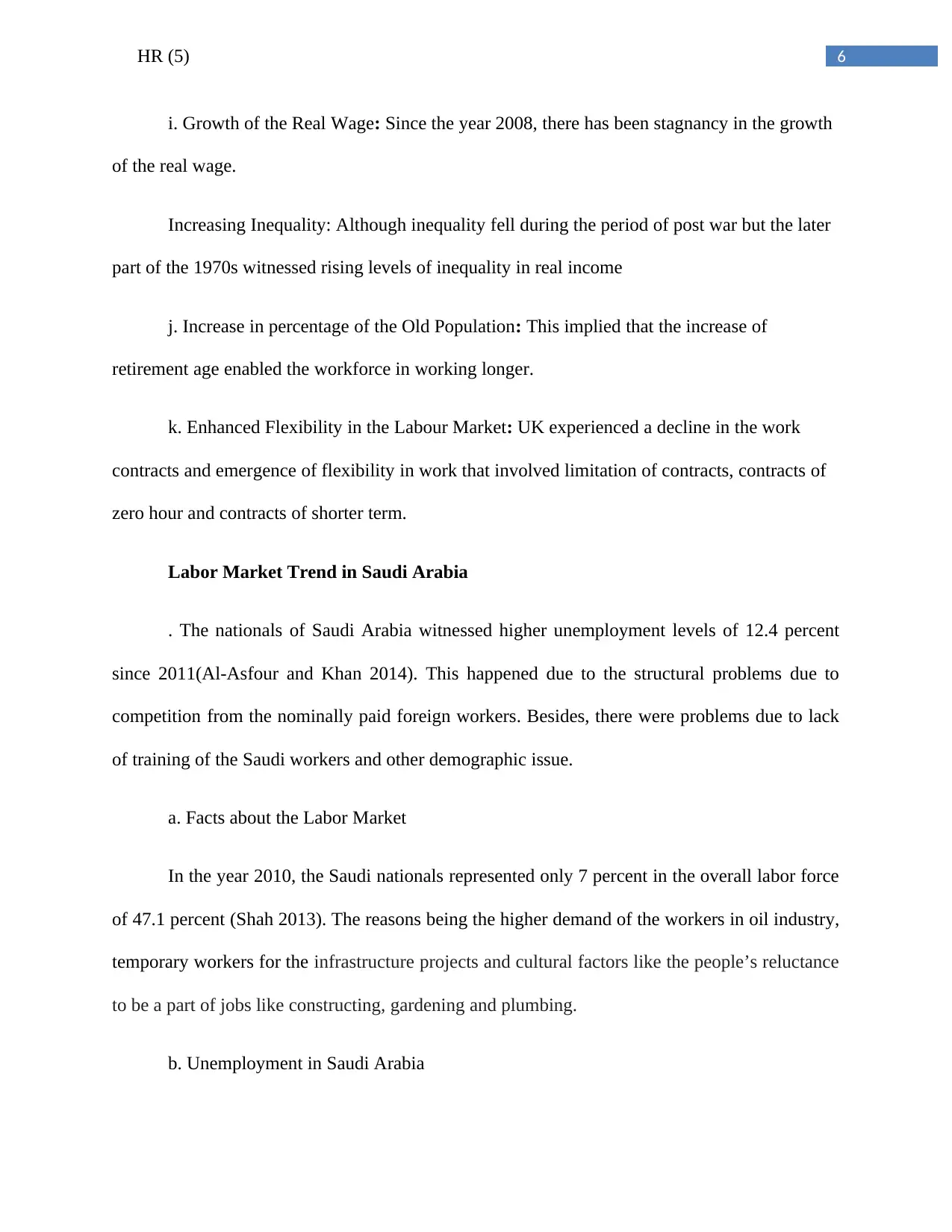
6HR (5)
i. Growth of the Real Wage: Since the year 2008, there has been stagnancy in the growth
of the real wage.
Increasing Inequality: Although inequality fell during the period of post war but the later
part of the 1970s witnessed rising levels of inequality in real income
j. Increase in percentage of the Old Population: This implied that the increase of
retirement age enabled the workforce in working longer.
k. Enhanced Flexibility in the Labour Market: UK experienced a decline in the work
contracts and emergence of flexibility in work that involved limitation of contracts, contracts of
zero hour and contracts of shorter term.
Labor Market Trend in Saudi Arabia
. The nationals of Saudi Arabia witnessed higher unemployment levels of 12.4 percent
since 2011(Al-Asfour and Khan 2014). This happened due to the structural problems due to
competition from the nominally paid foreign workers. Besides, there were problems due to lack
of training of the Saudi workers and other demographic issue.
a. Facts about the Labor Market
In the year 2010, the Saudi nationals represented only 7 percent in the overall labor force
of 47.1 percent (Shah 2013). The reasons being the higher demand of the workers in oil industry,
temporary workers for the infrastructure projects and cultural factors like the people’s reluctance
to be a part of jobs like constructing, gardening and plumbing.
b. Unemployment in Saudi Arabia
i. Growth of the Real Wage: Since the year 2008, there has been stagnancy in the growth
of the real wage.
Increasing Inequality: Although inequality fell during the period of post war but the later
part of the 1970s witnessed rising levels of inequality in real income
j. Increase in percentage of the Old Population: This implied that the increase of
retirement age enabled the workforce in working longer.
k. Enhanced Flexibility in the Labour Market: UK experienced a decline in the work
contracts and emergence of flexibility in work that involved limitation of contracts, contracts of
zero hour and contracts of shorter term.
Labor Market Trend in Saudi Arabia
. The nationals of Saudi Arabia witnessed higher unemployment levels of 12.4 percent
since 2011(Al-Asfour and Khan 2014). This happened due to the structural problems due to
competition from the nominally paid foreign workers. Besides, there were problems due to lack
of training of the Saudi workers and other demographic issue.
a. Facts about the Labor Market
In the year 2010, the Saudi nationals represented only 7 percent in the overall labor force
of 47.1 percent (Shah 2013). The reasons being the higher demand of the workers in oil industry,
temporary workers for the infrastructure projects and cultural factors like the people’s reluctance
to be a part of jobs like constructing, gardening and plumbing.
b. Unemployment in Saudi Arabia
Paraphrase This Document
Need a fresh take? Get an instant paraphrase of this document with our AI Paraphraser
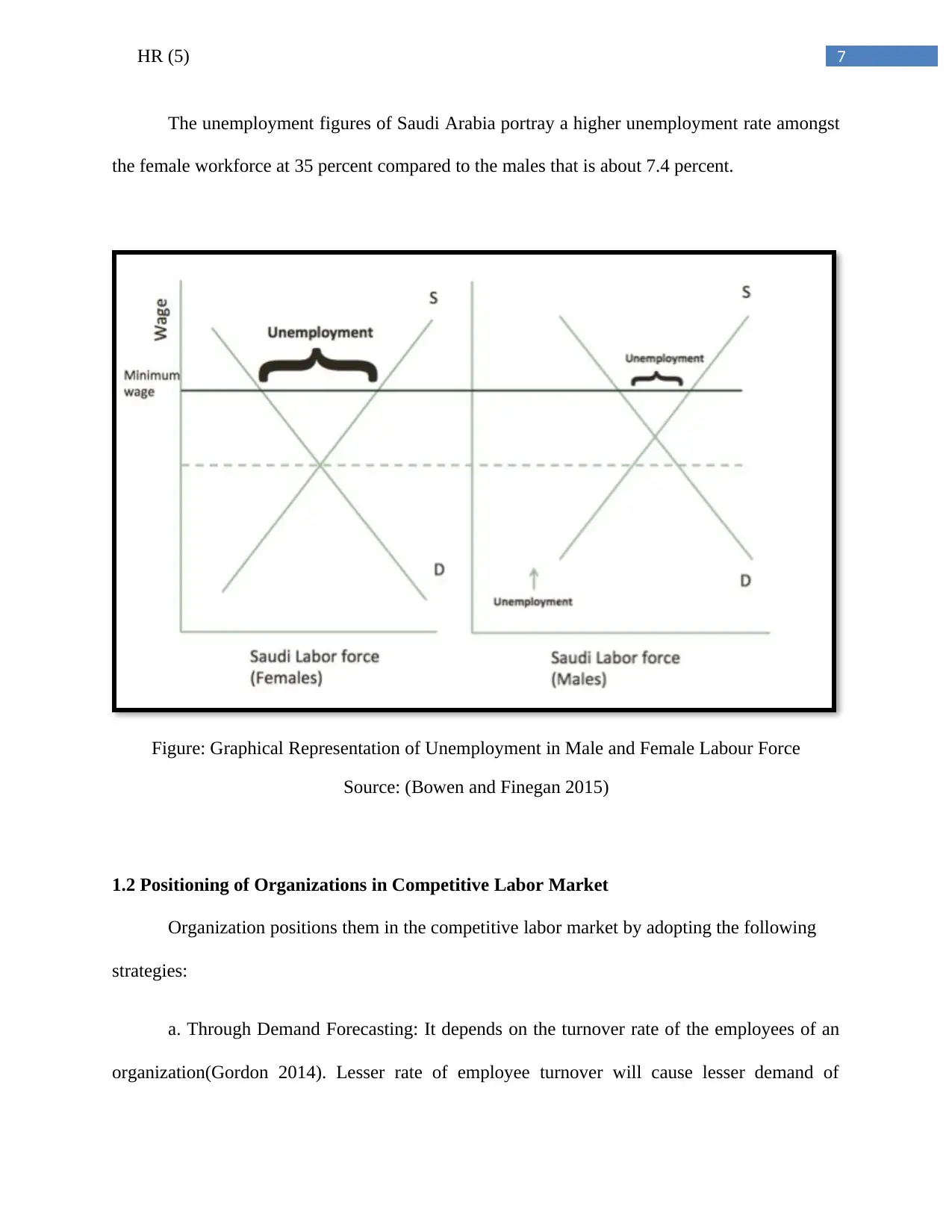
7HR (5)
The unemployment figures of Saudi Arabia portray a higher unemployment rate amongst
the female workforce at 35 percent compared to the males that is about 7.4 percent.
Figure: Graphical Representation of Unemployment in Male and Female Labour Force
Source: (Bowen and Finegan 2015)
1.2 Positioning of Organizations in Competitive Labor Market
Organization positions them in the competitive labor market by adopting the following
strategies:
a. Through Demand Forecasting: It depends on the turnover rate of the employees of an
organization(Gordon 2014). Lesser rate of employee turnover will cause lesser demand of
The unemployment figures of Saudi Arabia portray a higher unemployment rate amongst
the female workforce at 35 percent compared to the males that is about 7.4 percent.
Figure: Graphical Representation of Unemployment in Male and Female Labour Force
Source: (Bowen and Finegan 2015)
1.2 Positioning of Organizations in Competitive Labor Market
Organization positions them in the competitive labor market by adopting the following
strategies:
a. Through Demand Forecasting: It depends on the turnover rate of the employees of an
organization(Gordon 2014). Lesser rate of employee turnover will cause lesser demand of
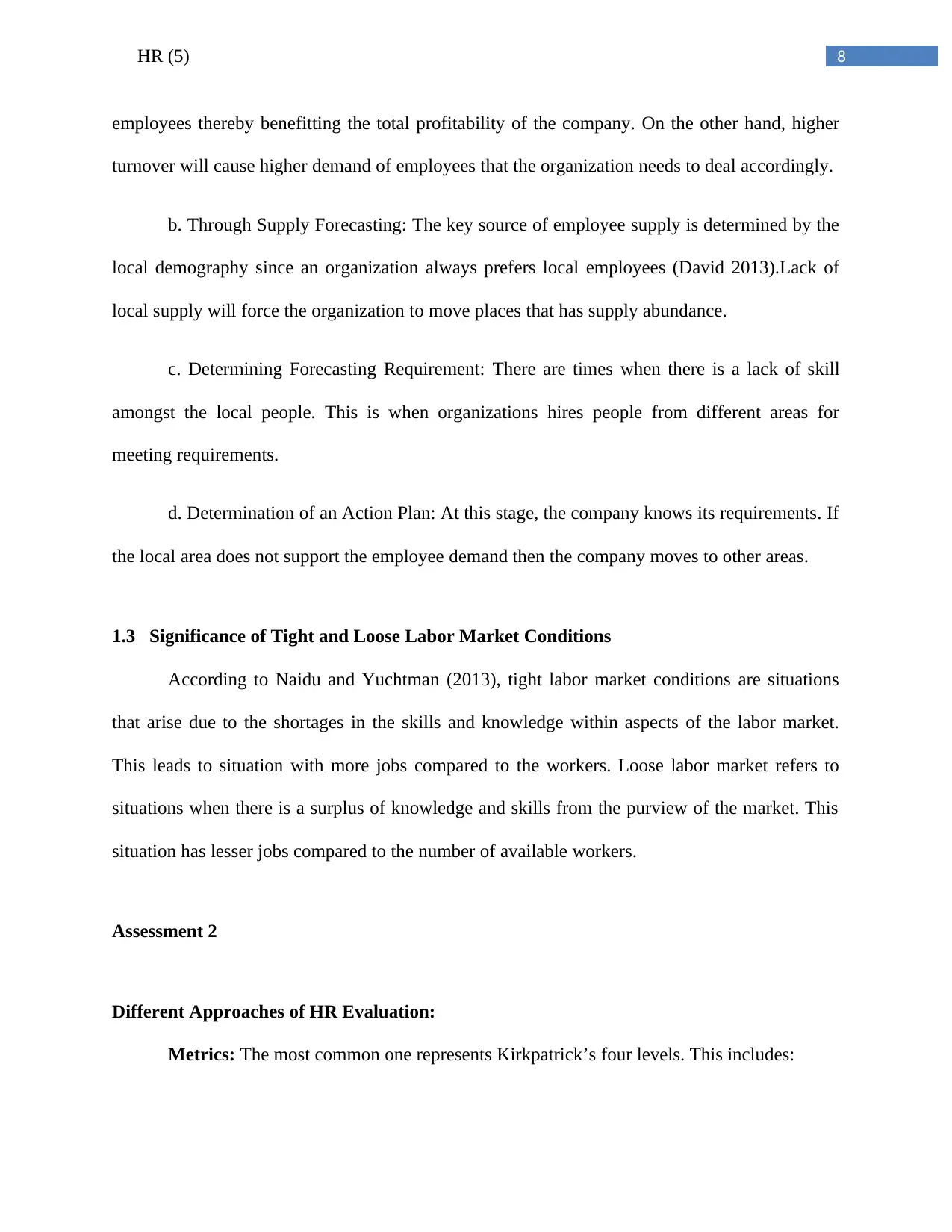
8HR (5)
employees thereby benefitting the total profitability of the company. On the other hand, higher
turnover will cause higher demand of employees that the organization needs to deal accordingly.
b. Through Supply Forecasting: The key source of employee supply is determined by the
local demography since an organization always prefers local employees (David 2013).Lack of
local supply will force the organization to move places that has supply abundance.
c. Determining Forecasting Requirement: There are times when there is a lack of skill
amongst the local people. This is when organizations hires people from different areas for
meeting requirements.
d. Determination of an Action Plan: At this stage, the company knows its requirements. If
the local area does not support the employee demand then the company moves to other areas.
1.3 Significance of Tight and Loose Labor Market Conditions
According to Naidu and Yuchtman (2013), tight labor market conditions are situations
that arise due to the shortages in the skills and knowledge within aspects of the labor market.
This leads to situation with more jobs compared to the workers. Loose labor market refers to
situations when there is a surplus of knowledge and skills from the purview of the market. This
situation has lesser jobs compared to the number of available workers.
Assessment 2
Different Approaches of HR Evaluation:
Metrics: The most common one represents Kirkpatrick’s four levels. This includes:
employees thereby benefitting the total profitability of the company. On the other hand, higher
turnover will cause higher demand of employees that the organization needs to deal accordingly.
b. Through Supply Forecasting: The key source of employee supply is determined by the
local demography since an organization always prefers local employees (David 2013).Lack of
local supply will force the organization to move places that has supply abundance.
c. Determining Forecasting Requirement: There are times when there is a lack of skill
amongst the local people. This is when organizations hires people from different areas for
meeting requirements.
d. Determination of an Action Plan: At this stage, the company knows its requirements. If
the local area does not support the employee demand then the company moves to other areas.
1.3 Significance of Tight and Loose Labor Market Conditions
According to Naidu and Yuchtman (2013), tight labor market conditions are situations
that arise due to the shortages in the skills and knowledge within aspects of the labor market.
This leads to situation with more jobs compared to the workers. Loose labor market refers to
situations when there is a surplus of knowledge and skills from the purview of the market. This
situation has lesser jobs compared to the number of available workers.
Assessment 2
Different Approaches of HR Evaluation:
Metrics: The most common one represents Kirkpatrick’s four levels. This includes:
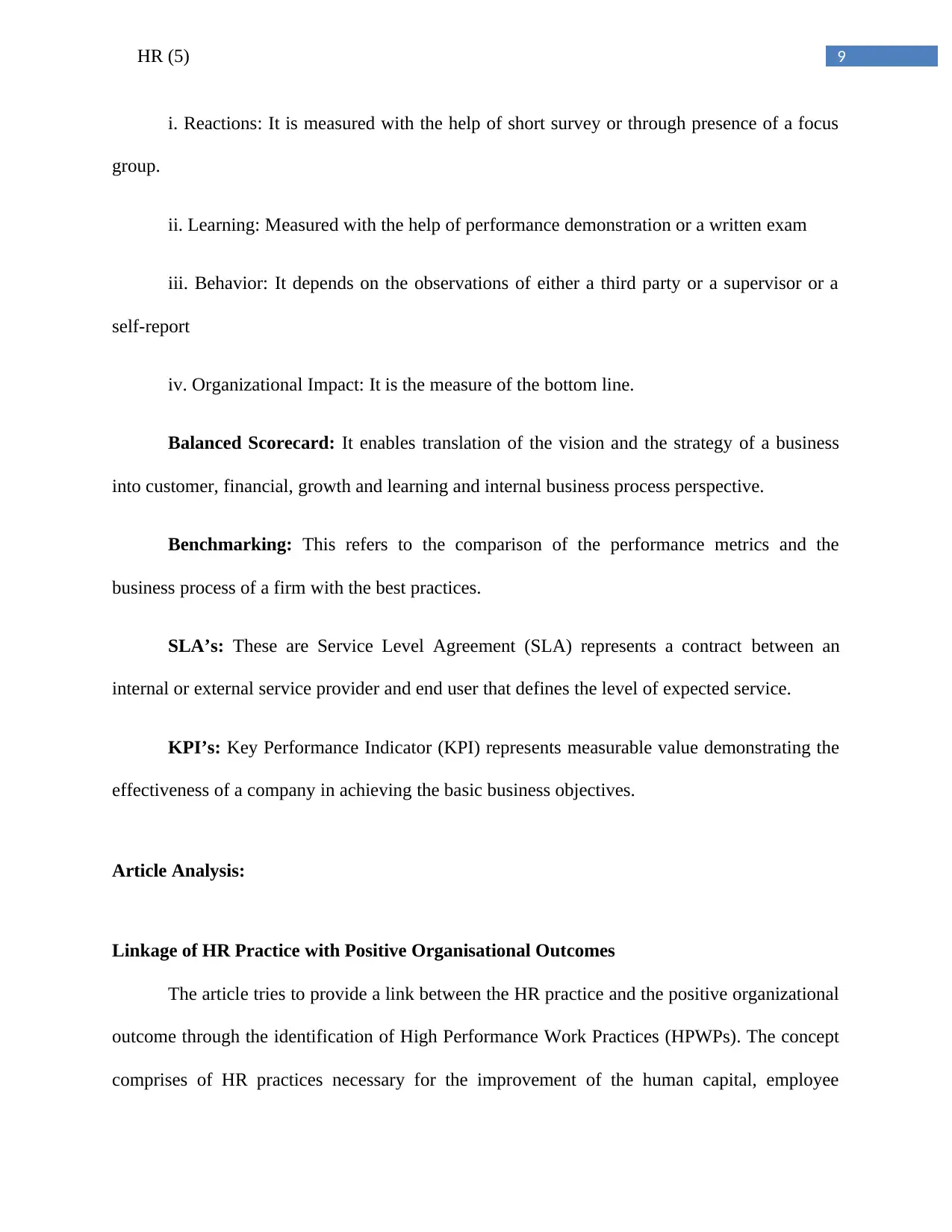
9HR (5)
i. Reactions: It is measured with the help of short survey or through presence of a focus
group.
ii. Learning: Measured with the help of performance demonstration or a written exam
iii. Behavior: It depends on the observations of either a third party or a supervisor or a
self-report
iv. Organizational Impact: It is the measure of the bottom line.
Balanced Scorecard: It enables translation of the vision and the strategy of a business
into customer, financial, growth and learning and internal business process perspective.
Benchmarking: This refers to the comparison of the performance metrics and the
business process of a firm with the best practices.
SLA’s: These are Service Level Agreement (SLA) represents a contract between an
internal or external service provider and end user that defines the level of expected service.
KPI’s: Key Performance Indicator (KPI) represents measurable value demonstrating the
effectiveness of a company in achieving the basic business objectives.
Article Analysis:
Linkage of HR Practice with Positive Organisational Outcomes
The article tries to provide a link between the HR practice and the positive organizational
outcome through the identification of High Performance Work Practices (HPWPs). The concept
comprises of HR practices necessary for the improvement of the human capital, employee
i. Reactions: It is measured with the help of short survey or through presence of a focus
group.
ii. Learning: Measured with the help of performance demonstration or a written exam
iii. Behavior: It depends on the observations of either a third party or a supervisor or a
self-report
iv. Organizational Impact: It is the measure of the bottom line.
Balanced Scorecard: It enables translation of the vision and the strategy of a business
into customer, financial, growth and learning and internal business process perspective.
Benchmarking: This refers to the comparison of the performance metrics and the
business process of a firm with the best practices.
SLA’s: These are Service Level Agreement (SLA) represents a contract between an
internal or external service provider and end user that defines the level of expected service.
KPI’s: Key Performance Indicator (KPI) represents measurable value demonstrating the
effectiveness of a company in achieving the basic business objectives.
Article Analysis:
Linkage of HR Practice with Positive Organisational Outcomes
The article tries to provide a link between the HR practice and the positive organizational
outcome through the identification of High Performance Work Practices (HPWPs). The concept
comprises of HR practices necessary for the improvement of the human capital, employee
Secure Best Marks with AI Grader
Need help grading? Try our AI Grader for instant feedback on your assignments.
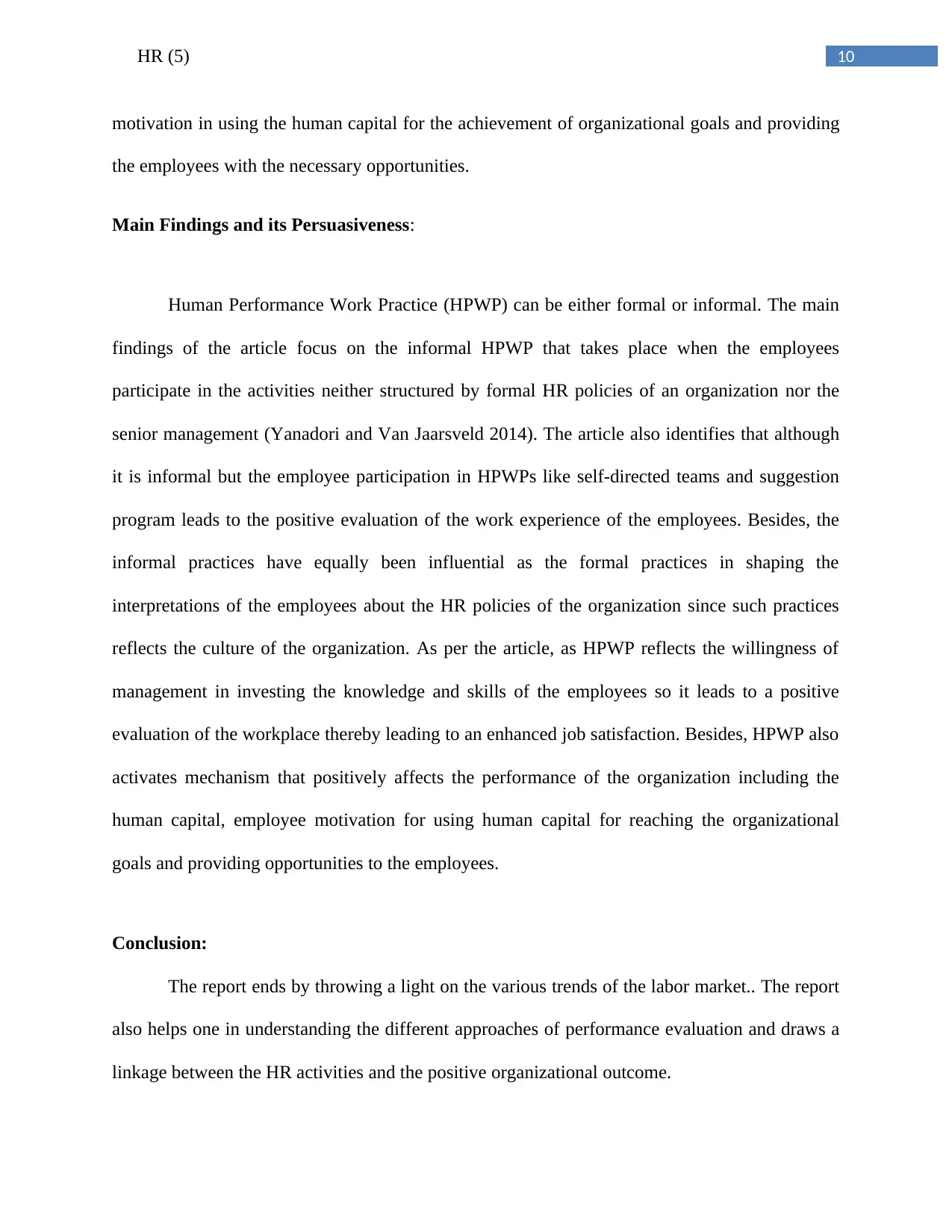
10HR (5)
motivation in using the human capital for the achievement of organizational goals and providing
the employees with the necessary opportunities.
Main Findings and its Persuasiveness:
Human Performance Work Practice (HPWP) can be either formal or informal. The main
findings of the article focus on the informal HPWP that takes place when the employees
participate in the activities neither structured by formal HR policies of an organization nor the
senior management (Yanadori and Van Jaarsveld 2014). The article also identifies that although
it is informal but the employee participation in HPWPs like self-directed teams and suggestion
program leads to the positive evaluation of the work experience of the employees. Besides, the
informal practices have equally been influential as the formal practices in shaping the
interpretations of the employees about the HR policies of the organization since such practices
reflects the culture of the organization. As per the article, as HPWP reflects the willingness of
management in investing the knowledge and skills of the employees so it leads to a positive
evaluation of the workplace thereby leading to an enhanced job satisfaction. Besides, HPWP also
activates mechanism that positively affects the performance of the organization including the
human capital, employee motivation for using human capital for reaching the organizational
goals and providing opportunities to the employees.
Conclusion:
The report ends by throwing a light on the various trends of the labor market.. The report
also helps one in understanding the different approaches of performance evaluation and draws a
linkage between the HR activities and the positive organizational outcome.
motivation in using the human capital for the achievement of organizational goals and providing
the employees with the necessary opportunities.
Main Findings and its Persuasiveness:
Human Performance Work Practice (HPWP) can be either formal or informal. The main
findings of the article focus on the informal HPWP that takes place when the employees
participate in the activities neither structured by formal HR policies of an organization nor the
senior management (Yanadori and Van Jaarsveld 2014). The article also identifies that although
it is informal but the employee participation in HPWPs like self-directed teams and suggestion
program leads to the positive evaluation of the work experience of the employees. Besides, the
informal practices have equally been influential as the formal practices in shaping the
interpretations of the employees about the HR policies of the organization since such practices
reflects the culture of the organization. As per the article, as HPWP reflects the willingness of
management in investing the knowledge and skills of the employees so it leads to a positive
evaluation of the workplace thereby leading to an enhanced job satisfaction. Besides, HPWP also
activates mechanism that positively affects the performance of the organization including the
human capital, employee motivation for using human capital for reaching the organizational
goals and providing opportunities to the employees.
Conclusion:
The report ends by throwing a light on the various trends of the labor market.. The report
also helps one in understanding the different approaches of performance evaluation and draws a
linkage between the HR activities and the positive organizational outcome.
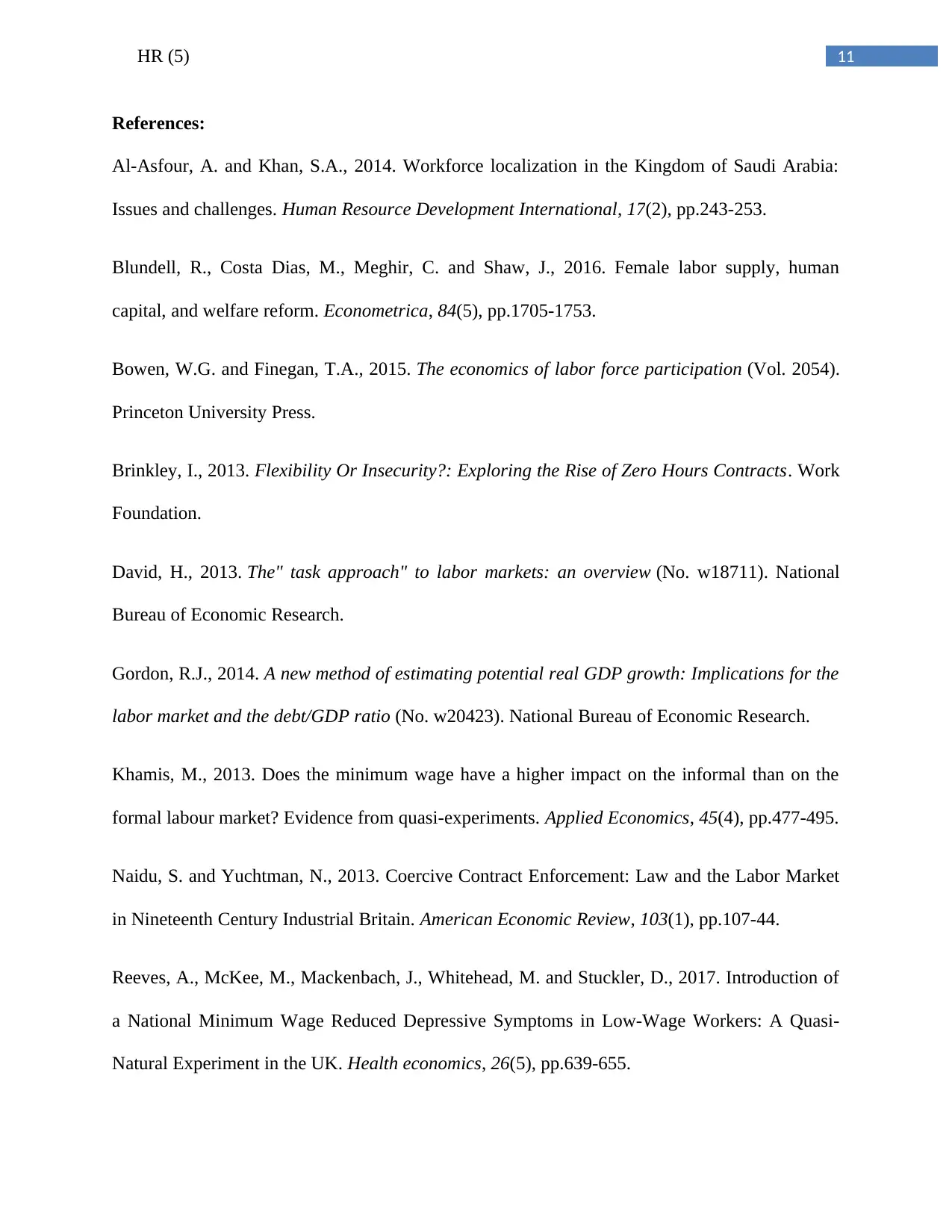
11HR (5)
References:
Al-Asfour, A. and Khan, S.A., 2014. Workforce localization in the Kingdom of Saudi Arabia:
Issues and challenges. Human Resource Development International, 17(2), pp.243-253.
Blundell, R., Costa Dias, M., Meghir, C. and Shaw, J., 2016. Female labor supply, human
capital, and welfare reform. Econometrica, 84(5), pp.1705-1753.
Bowen, W.G. and Finegan, T.A., 2015. The economics of labor force participation (Vol. 2054).
Princeton University Press.
Brinkley, I., 2013. Flexibility Or Insecurity?: Exploring the Rise of Zero Hours Contracts. Work
Foundation.
David, H., 2013. The" task approach" to labor markets: an overview (No. w18711). National
Bureau of Economic Research.
Gordon, R.J., 2014. A new method of estimating potential real GDP growth: Implications for the
labor market and the debt/GDP ratio (No. w20423). National Bureau of Economic Research.
Khamis, M., 2013. Does the minimum wage have a higher impact on the informal than on the
formal labour market? Evidence from quasi-experiments. Applied Economics, 45(4), pp.477-495.
Naidu, S. and Yuchtman, N., 2013. Coercive Contract Enforcement: Law and the Labor Market
in Nineteenth Century Industrial Britain. American Economic Review, 103(1), pp.107-44.
Reeves, A., McKee, M., Mackenbach, J., Whitehead, M. and Stuckler, D., 2017. Introduction of
a National Minimum Wage Reduced Depressive Symptoms in Low‐Wage Workers: A Quasi‐
Natural Experiment in the UK. Health economics, 26(5), pp.639-655.
References:
Al-Asfour, A. and Khan, S.A., 2014. Workforce localization in the Kingdom of Saudi Arabia:
Issues and challenges. Human Resource Development International, 17(2), pp.243-253.
Blundell, R., Costa Dias, M., Meghir, C. and Shaw, J., 2016. Female labor supply, human
capital, and welfare reform. Econometrica, 84(5), pp.1705-1753.
Bowen, W.G. and Finegan, T.A., 2015. The economics of labor force participation (Vol. 2054).
Princeton University Press.
Brinkley, I., 2013. Flexibility Or Insecurity?: Exploring the Rise of Zero Hours Contracts. Work
Foundation.
David, H., 2013. The" task approach" to labor markets: an overview (No. w18711). National
Bureau of Economic Research.
Gordon, R.J., 2014. A new method of estimating potential real GDP growth: Implications for the
labor market and the debt/GDP ratio (No. w20423). National Bureau of Economic Research.
Khamis, M., 2013. Does the minimum wage have a higher impact on the informal than on the
formal labour market? Evidence from quasi-experiments. Applied Economics, 45(4), pp.477-495.
Naidu, S. and Yuchtman, N., 2013. Coercive Contract Enforcement: Law and the Labor Market
in Nineteenth Century Industrial Britain. American Economic Review, 103(1), pp.107-44.
Reeves, A., McKee, M., Mackenbach, J., Whitehead, M. and Stuckler, D., 2017. Introduction of
a National Minimum Wage Reduced Depressive Symptoms in Low‐Wage Workers: A Quasi‐
Natural Experiment in the UK. Health economics, 26(5), pp.639-655.
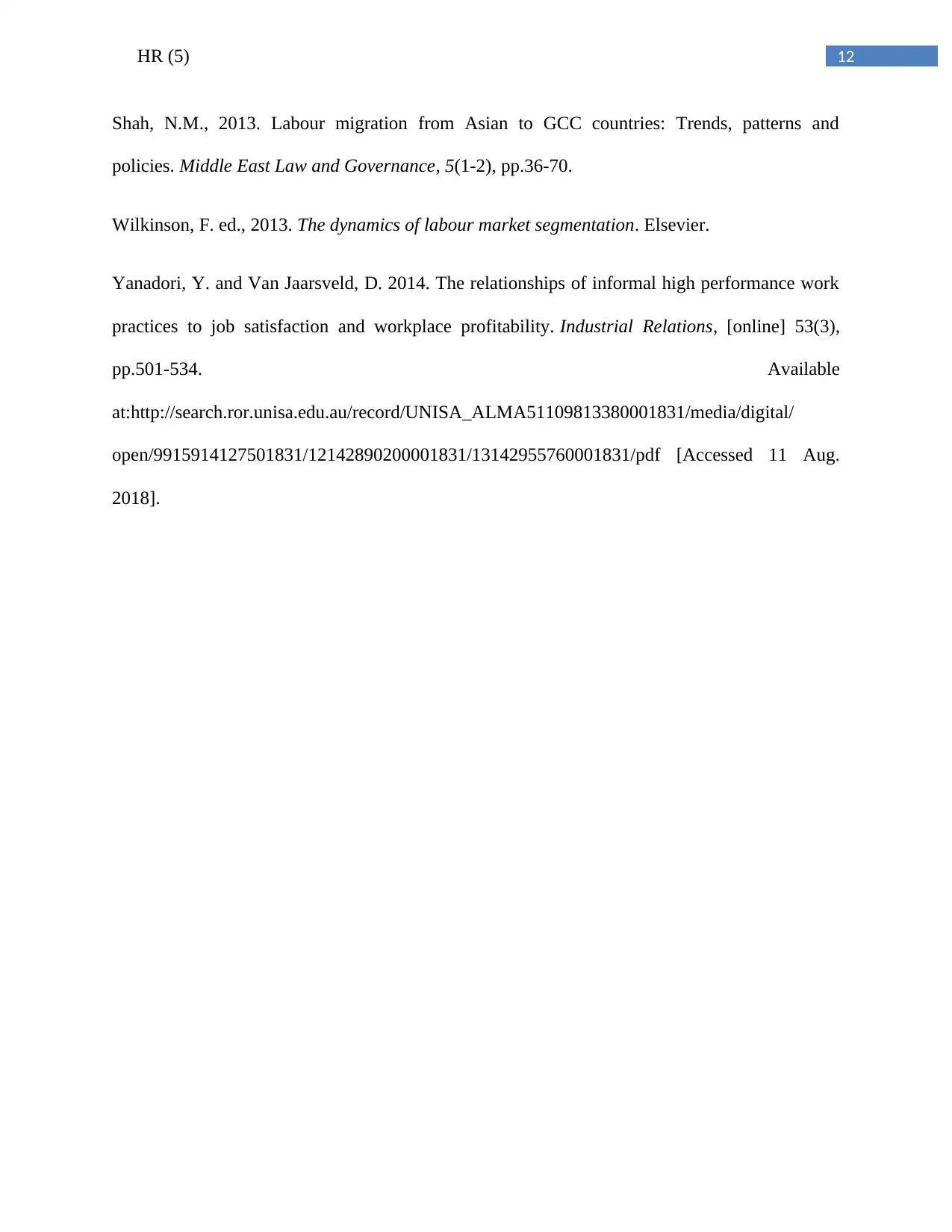
12HR (5)
Shah, N.M., 2013. Labour migration from Asian to GCC countries: Trends, patterns and
policies. Middle East Law and Governance, 5(1-2), pp.36-70.
Wilkinson, F. ed., 2013. The dynamics of labour market segmentation. Elsevier.
Yanadori, Y. and Van Jaarsveld, D. 2014. The relationships of informal high performance work
practices to job satisfaction and workplace profitability. Industrial Relations, [online] 53(3),
pp.501-534. Available
at:http://search.ror.unisa.edu.au/record/UNISA_ALMA51109813380001831/media/digital/
open/9915914127501831/12142890200001831/13142955760001831/pdf [Accessed 11 Aug.
2018].
Shah, N.M., 2013. Labour migration from Asian to GCC countries: Trends, patterns and
policies. Middle East Law and Governance, 5(1-2), pp.36-70.
Wilkinson, F. ed., 2013. The dynamics of labour market segmentation. Elsevier.
Yanadori, Y. and Van Jaarsveld, D. 2014. The relationships of informal high performance work
practices to job satisfaction and workplace profitability. Industrial Relations, [online] 53(3),
pp.501-534. Available
at:http://search.ror.unisa.edu.au/record/UNISA_ALMA51109813380001831/media/digital/
open/9915914127501831/12142890200001831/13142955760001831/pdf [Accessed 11 Aug.
2018].
1 out of 13
Related Documents
Your All-in-One AI-Powered Toolkit for Academic Success.
+13062052269
info@desklib.com
Available 24*7 on WhatsApp / Email
![[object Object]](/_next/static/media/star-bottom.7253800d.svg)
Unlock your academic potential
© 2024 | Zucol Services PVT LTD | All rights reserved.
